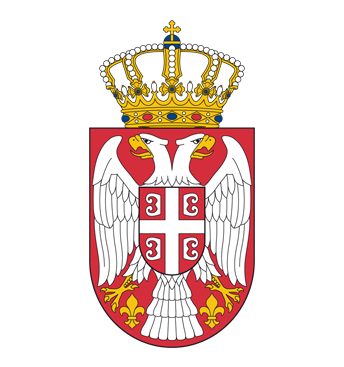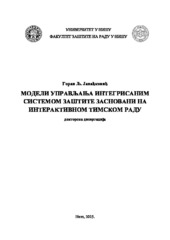Modeli upravljanja integrisanim sistemom zaštite zasnovani na interaktivnom timskom radu
Models for integrated safety system management based on collaborative work
Докторанд
Janaćković, Goran Lj.Ментор
Savić, SuzanaЧланови комисије
Anđelković, BranislavStanković, Miomir
Papić, Ljubiša
Pamučar, Dragan

Метаподаци
Приказ свих података о дисертацијиСажетак
In the last 30 years, we have witnessed significant improvements in safety concept, as well as
methods and tools for risk analysis of complex socio-technical systems. However, many
studies show that a large number of accidents still happen due to poor organization and
management of safety, problems with communication and information exchange, as well as
inadequate including of safety processes in the business processes of the organization. In fact,
there are a number of systems and processes related to safety that are separated and
independently developed in an organization. The result is, often, ineffective safety system.
There is evident development of safety lifecycle standards and models. The models of safety
lifecycle can contribute to better control of safety if safety processes are integrated with other
organizational processes. An integrated view on safety processes leads to greater validation
and certification of the entire lifecycle of the organization. Therefore, the lifecyc...le of an
integrated safety system is proposed. An integrated safety system is a unique system that
interacts or covers, partially or completely, the following systems and processes: quality
system, technical systems, occupational safety systems, fire and environmental protection
systems, technological processes, planning processes, risk assessment, maintenance,
monitoring and verification (monitoring and audits), training, organizational learning, change
management , emergency response, reporting and documentation, as well as the process of
managing resources (human, intellectual, material, financial). An integrated safety system
integrates the technical systems with human resources, and provides a documented risk
management.
The efficiency of the integrated safety system is an important aspect of the research. In the
process of research, the key performance indicators, their limits and criteria for the
integration of these systems and processes are identified.
For the analysis of integrated safety system a hierarchical model is applied. It covers three
basic criteria: risk, costs and social responsibility. In the context of the criteria, four subcriteria
are considered. They describe technical and technological, human, organizational and
environmental factors. The term „safety performance” includes a set of indicators that
quantitatively or qualitatively describe the specific effects contribution, the results that are
achieved in the safety system. Based on them, the following groups of safety performance
indicators are selected: general, and specific to a particular industry or activity. Performance
indicators define how safety level changes over time, as a result of the actions that have been
carried out with the aim of reducing the corresponding risk. The effectiveness of safety is
assessed according to the value of safety performance and organisational performance, and it
is „measured" by corresponding indicators. Two different classes of safety indicators are
considered: activity indicators (indirect indicators or leading indicators), and outcome
indicators (direct indicators and lagging indicators). The structure of factors, performance and
indicators of occupational safety is presented.
As the success factors of the efficient safety system integration, the following factors are
identified: compliance of safety procedures with work processes; existence of guidelines for
the integration of safety and protection procedures; precise definition of safety levels;
exchange of safety knowledge; skills for safety integration; implementation of legal norms
and standards; technical support; effective safety reporting; employees' skills in
communication and reporting; functionality of supporting technologies for the integration; the
existence of mechanisms for continuous safety improvement; efficient management of safety
resources and setting priorities; personnel training on coordination and collaboration;
maintenance strategies, intensity and cost of integrated safety system; availability of funds
and databases on safety outcomes; clear roles in safety management; line management
responsibility for safety.
During the analysis of safety system control, the following models are identified: safety
activity control model, safety lifecycle activity control model, the model of acceptable
performance, model of organizational accidents and hybrid models. Hybrid models are
recognized as an effective tool for analysing multi-disciplinary nature of the safety system at
organizational level, and relevant working framework for risk assessment.
Due to the multidisciplinary nature of safety system, it is unavoidable to apply collaborative
work in its implementation, development and management. Collaborative work, supported by
information technology, provides optimal lifecycle control of an integrated safety system.
The proposed model of collaborative work in the integrated safety system contains elements
that describe the activities performed by an individual or group, independent or in
conjunction with individuals or groups, using existing communication channels, databases
and available organizational resources. The models of interaction and success factors of
teamwork are presented. The community of practice for safety is described and factors of
success are identified.
In order to achieve effective management of an integrated safety system, a computer support
is needed. Tools used in the process of documentation of safety system as well as decisionmaking
are described. The model of documenting in an integrated safety system at the
enterprise level is proposed.
The practical part of the research was carried out in road construction companies in Serbia.
Factors, performance and indicators of safety, as well as a method for ranking and selection
of safety indicators based on the evaluations of experts and fuzzy analytic hierarchy process
is applied to road construction companies in Serbia. The key performance indicators of safety
are identified and ranked based on risk analysis. The study confirmed the importance of
organizational factors for the quality of the safety system and the dominance of activity
indicators: the efficiency level of resource management, the number of safety inspections in
practice, the level of safety technologies, monitoring work procedures and reducing the
number of high level risk operations.
The method of application of key safety performance indicators is proposed for: creation of
bases of data, information and knowledge on safety; building models and concepts of safety;
better quality of integrated safety system management; as well as decision support and
teamwork.
The research presented in the dissertation is based on systems approach during the analysis of
integrated safety system, as well as the application of multi-criteria methods during the
decision making. The value of the research is based on the following results:
• performance and criteria for integration of safety systems are obtained;
• the safety lifecycle model of integrated safety system is defined;
• the algorithm for multi-criteria decision making in safety is developed;
• the community of practice for safety is described and key success factors are
identified;
• the model for reporting and documenting of safety management at organisational
level is defined;
• tools for multi-criteria analysis of safety system, based on analytic hierarchy process
(AHP) and fuzzy analytic hierarchy process (Fuzzy AHP) are created;
• the model of collaborative work and the model of the decision support system for
safety are proposed.
The results of the doctoral dissertation are the original scientific contribution, which is
reflected in the way the analysis of the safety system as an integrated system is obtained, with
respect to the effects of technology, individuals, organizations and the environment on health
and safety, environmental protection and emergency response.
The applicability of the integrated safety system is high in large organizations, but also in
small and medium organizations, that can pool their limited safety resources in safety
communities of practice.
The obtained results represent the basis for the creation of web services for the accumulation,
storage, use and maintenance of the knowledge base on risk assessment and team decisionmaking
support. It can also initiate the research in the field of quantification of the impact of
the integrated safety system on the performance of an organization.
Doctoral dissertation is the result of years of author’s own research carried out independently
and in collaboration with colleagues from the Faculty of occupational safety in Nis, Faculty
of electronic engineering in Nis, and The Institute for the quality of working and living
environment „1. May”, Nis.
Факултет:
Универзитет у Нишу, Факултет заштите на радуДатум одбране:
19-06-2015Пројекти:
- Истраживање и развој енергетски и еколошки високоефективних система полигенерације заснованих на обновљивим изворима енергије (RS-MESTD-Integrated and Interdisciplinary Research (IIR or III)-42006)
- Развој нових информационо-комуникационих технологија, коришћењем напредних математичких метода, са применама у медицини, телекомуникацијама, енергетици, заштитити националне баштине и образовању (RS-MESTD-Integrated and Interdisciplinary Research (IIR or III)-44006)



